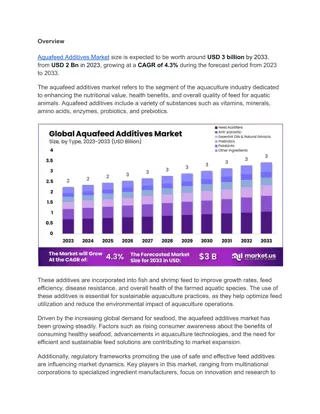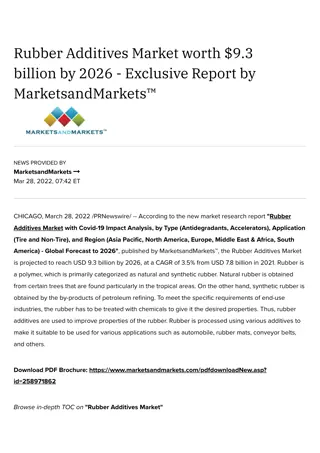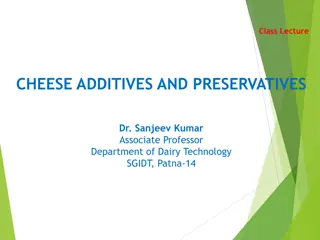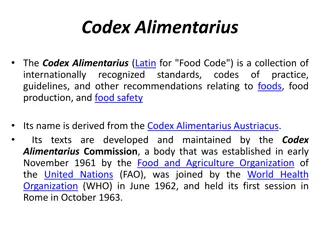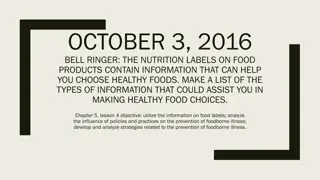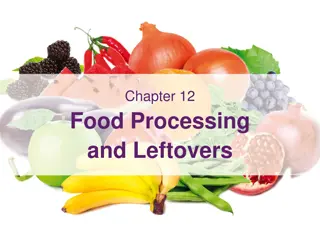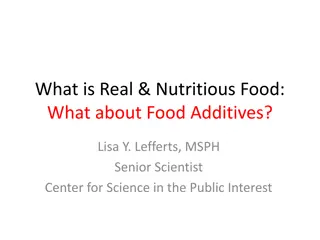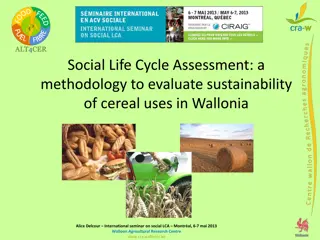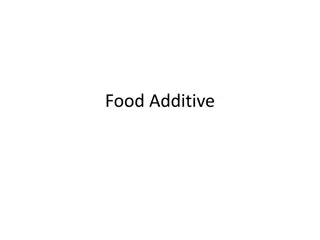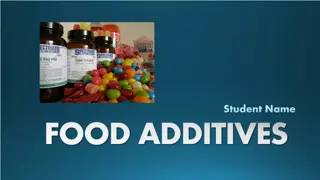Understanding Food Additives: Types, Regulation, and Uses
Food additives play a crucial role in preserving, enhancing, and processing foods. They can be natural or synthetic substances added to food for specific purposes. Regulated by the FDA, these additives aim to improve storage properties, increase healthfulness, enhance appeal, and aid in food processing. Learn about common additives, their uses, and the distinction between natural and synthetic varieties in this comprehensive guide.
Download Presentation

Please find below an Image/Link to download the presentation.
The content on the website is provided AS IS for your information and personal use only. It may not be sold, licensed, or shared on other websites without obtaining consent from the author. Download presentation by click this link. If you encounter any issues during the download, it is possible that the publisher has removed the file from their server.
E N D
Presentation Transcript
Chapter 24 Food Additives http://www.hungryforchange.tv/images/assets/Food-Additives-Examples.jpg By: Lexi Carp, Devon Grissinger, and Nina Salvucci
Objectives and Vocabulary Vocab: -Food Additives Food Additives -GRAS List GRAS List - -Enrichment Enrichment - -Fortification Fortification -Restoration Restoration -Nitrification Nitrification - -Goiter Goiter - -Stabilizer Stabilizer Objectives: Identify common food additives and their uses Compare natural and synthetic additives Explain how additives are regulated Identify general and specific uses of preservatives Compare methods for adding nutrients to foods Describe how additives make food more appealing Describe how additives aid food processing Evaluate the pros and cons of using food additives
What is a Food Additive? Any substance a food producer intentionally adds to a food for a specific purpose Around 3,000 additives used to preserve foods Natural and Synthetic additives Natural Natural Additives such as salt and sugars have been around thousands of years Occur naturally in food or plants Synthetic Synthetic Artificial or synthetic additives are made in a laboratory Not found naturally in food
Regulating Additives (FDA)The Food and Drug Administration is responsible for keeping food safe for consumers FDA holds manufacturers accountable for labeling additives in food products There are four purposes of additives Improve storage properties Improve storage properties Increase healthfulness Increase healthfulness Make food more appealing Make food more appealing Improve processing and preparing Improve processing and preparing
GRAS GRAS List List contains substances, like spices, natural seasonings, and flavorings, that are considered safe for human consumption (not regulated as additives) additives) not regulated as
How Additives are Used Improving Storage Properties Preservatives-chemicals used to prevent mold and bacteria from spoiling food Don t affect a food s flavor, color , or texture Preservatives can have an added purpose To color and flavor cured meats
Increasing Healthfulness Fortification adding nutrients not normally found in the food Restoration nutrients that are lost in processing are returned to the food Enrichment adding nutrients lost in processing back in the food along with extra nutrients that did not exist before
Making Food More Appealing Color: Color: Synthetic coloring is safe/FDA approved. Natural coloring may come from caramelization Flavor: Flavor: Most flavoring is artificial and flavor enhancers are made from the amino acid glutamate Sweeteners: Sweeteners: Sucralose, saccharin, aspartame, and acesulfame Nonnutritive sugars- artificial sweeteners and have no calories. Nutritive sweeteners- natural and metabolize to produce calories. Food Additives (3:47) http://www.abc.net.au/btn/story/s3340159.htm
Improving, Processing and Preparation Stabilizers Stabilizers and thickeners thickeners are usually natural additives and they contribute to the body of the food Stabilizer Stabilizer- - A substance that keeps a compound, mixture, or solution from changing its form or chemical nature
Concerns About Food Additives Long Long- -term effects: term effects: Scientists found that nitrates can cause cancer over time and under extreme heat Food Allergies/Sensitivities: Food Allergies/Sensitivities: Reactions to MSG, sulfites, and BHT are rare but can be severe; they are also difficult to avoid
Food Additives Pros: Pros: Food is more appealing to the eye and tasty Cons: Cons: Long term effects such as cancer Food allergies to additives are hard to avoid and can be severe
Poor Eating Habits Leads to nutrient deficiencies Adding nutrients where they don t occur naturally makes getting balanced nutrition more confusing
Unneeded Additives Wax on apples, oranges, eggplant and lemons are FDA-approved as preservative -maintain freshness by sealing in moisture Critics warn that by conditioning buyers to set unnatural standards for foods, producers discourage people from eating what s really good for them Using additives raises the price of the product
The Value of Food Additives Safety Proponents stress that producers and consumers alike now rely on additives to help ensure a safe food supply Preservatives extend the shelf life of some products -A loaf of bread stays edible because of the mold inhibitor calcium propionate and the BHT that keeps fats from going rancid, additive ethylenediamine tetraacetic acid helps prevent rancidity Improves Nutrition Supporters say additives prevent diseases caused by malnutrition First case of fortification in the United States was prompted by high rates of goiter, an enlargement of the thyroid gland caused by lack of iodine. Vitamin D to milk in the 1930s Fortifying flour and cornmeal with iron and niacin Preservatives
World Hunger With additives, foods can be shipped safely over long distances Supporters suggest that some fears about using additives are a reaction against using chemicals Chemical additives are no more dangerous than the food itself




